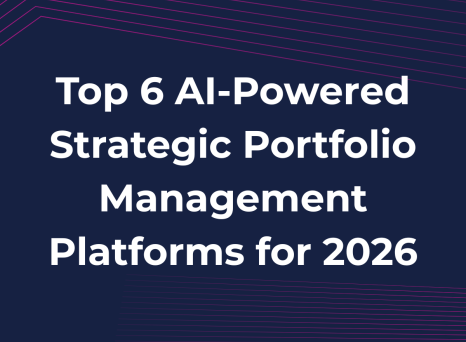Imagine a career in academia and skyrocketing to leading roles in global companies. Dr. Henri Molhuizen spent 18 years at Unilever, became VP of R&D at Dawn Foods, and explored AI-driven innovations at Meritas. Now, as a senior research and development executive consultant with Foodiract, he helps companies make strategic choices in R&D and innovation management.
On a recent Planisware webinar, Dr. Molhuizen shared his knowledge, which I’ve boiled down into a handy guide. Let's dive into food and beverage industry innovation and management, tackle some industry challenges, and explore the latest tech advancements that are shaking things up.
Food and Beverage Innovation Management
Innovation doesn't just happen by chance. It needs structure and strategy. According to Dr. Molhuizen, managing innovation is like juggling three balls: project management, program management, and portfolio management.
- Project Management. This focuses on specific projects led by project managers to ensure they get the resources they need to succeed. Think of it as keeping one ball in the air—doable and manageable.
- Program Management. Now, add a second ball. This level is about leaders managing groups of related projects within a business unit. It makes sure these projects align with your strategic goals and support each other.
- Portfolio Management. Here comes the third ball—the big picture led and owned by senior leaders. Portfolio growth drives complexity, so it’s about overseeing all innovation projects across the company, ensuring they align with the overall business strategy, and driving maximum return on investment.
Dr. Molhuizen’s key takeaway is each level is crucial, and they need to work in harmony to ensure your innovation efforts hit the mark. Or, as he also puts it, “doing the right things, and doing the things right.”
Challenges and Solutions
The food and beverage industry is extremely competitive. That competition drives many factors including cost, margin, time to market, risk, and others. Dr. Molhuizen highlighted a few important things to contend with:
- Consumer Preferences - These can vary widely, not just from country to country, but even within regions. For example, preferences in northern and southern parts of the Netherlands can be quite different. These include nutrition and health, price, perceived value, culture, personal habits and more.
- Operations - Navigating the maze of regulations in various markets can be a major headache. Every country has its own set of rules, making compliance a complex task. Managing supply chains from raw material sourcing to product delivery is no small feat. Factors like material availability, safety standards, seasonality, and distribution systems can create significant hurdles.
- Strategy - A product needs to align with a brand’s image and a company’s reputation, something that carries a high level of risk. The product should comport well with public opinion, provide value for the consumer and drive value for investors.
PepsiCo Uses Planisware for its Digital Innovation Agenda
So, what's the solution? Dr. Molhuizen’s advice is clear and practical.
- Robust R&D Management. Invest in strong R&D processes. This helps to develop products that meet diverse consumer needs while complying with various regulations.
- Strategic Portfolio Oversight. Keep an eye on the big picture. Ensure all your projects align with your strategic goals and prioritize those that offer the best return on investment.
- Professional PPM Tools. Leverage the latest tools to maintain clarity and control, even as your project complexity increases. These tools help integrate all your project data into one source of truth, making it easier to manage.
Technology Advancements and What They Mean
Finally, Dr. Molhuizen is enthusiastic about how technology is changing the industry.
- Artificial Intelligence (AI) - Too often there is insufficient learning from projects, both finished and unfinished. AI can analyze vast amounts of data to identify patterns, predict risks, and streamline decision-making processes for optimized risk management and mitigation. AI can recognize and report on hidden patterns in consumer behavior or help optimize supply chain logistics.
- Digital Transformation - Digital tools enhance project and portfolio management. They offer automatic reporting, optimize risk management, and help recognize hidden patterns in data. This means less time spent on manual tasks and more time on strategic decision-making.
Dr. Molhuizen believes these technologies offer substantial opportunities for innovation and growth. By embracing AI and digital tools, companies can stay ahead of the curve and respond more quickly to market changes.
Conclusion - Innovation Responsibly and Sustainably
So, what's Dr. Molhuizen's final piece of advice for leaders in the food and beverage industry? Innovate responsibly and sustainably. Here's how:
- Make Smart Choices: Always align your innovation efforts with your strategic goals. Focus on projects that offer the best return on investment and align with consumer demands.
- Stay Ahead of Trends: Keep an eye on emerging trends and be ready to adapt. Whether it's globalization trends, the shift towards plant-based proteins, or new digital tools, staying ahead of trends can help you stay competitive.
- Build Brand Equity: Ensure your products not only meet consumer needs but also build your brand’s reputation. Quality, safety, and sustainability should be at the forefront of your innovation efforts.
By following these principles, you can ensure that your company not only keeps up with industry trends but also stays ahead, building a strong, sustainable brand that consumers trust.
Watch the webinar Dr. Henri on Streaming R&D in FMCG with Project and Portfolio Management



